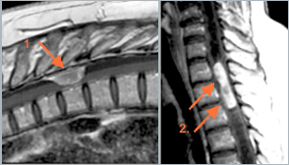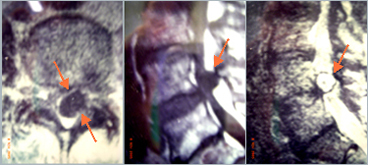Tumours in the spinal canal and the spinal cord
In addition to bony impingement there may be tumorous growths e.g. meningeomas or neurinomas in the spinal canal and cord, which may require removal by an operation. Most intradurally situated lesions are benign but by exercising pressure upon the nerve roots or the spinal cord may cause symptoms as severe as paralysis. Removal of these growths by means of a microsurgical operation is the therapy of choice.

Intraspinal tumours (MRI):
Benign meningeoma at D 4 level (arrow 1) (left)
Intramedullary tumor(arrows 2) (right)
Cysts of the intervertebral joints
These cysts are situated dorsally to the nerve root and the thecal sac and originate as a sign of severe and long lasting degeneration of the joint capsule due to disc degeneration. The symptoms are similar to those of a disc herniation. Cysts producing pressure symptoms upon a nerve root require removal by an operation, which has excellent results.

MRI of intraspinal synovial (zygoapophyseal) cysts (arrows)
Lipoma in the spinal canal
Normally a thin layer of fatty tissue around the thecal sac and the nerve roots facilitates the motion of these structures in the spinal canal. However in some cases this layer can thicken and exercise pressure upon the thecal sac and/or the nerve roots. Lipomas may spread over several segments and thus lead to symptoms similar to spinal stenosis or disc herniation. Spinal lipomatosis can only be diagnosed by MRI. In the case of such symptoms, an operation, using a minimally invasive open approach is indicated and results are usually excellent.
